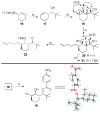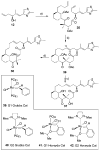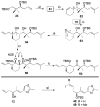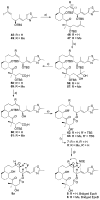C6-C8 bridged epothilones: consequences of installing a conformational lock at the edge of the macrocycle
- PMID: 22127984
- PMCID: PMC3248799
- DOI: 10.1002/chem.201102630
C6-C8 bridged epothilones: consequences of installing a conformational lock at the edge of the macrocycle
Abstract
A series of conformationally restrained epothilone analogues with a short bridge between the methyl groups at C6 and C8 was designed to mimic the binding pose assigned to our recently reported EpoA-microtubule binding model. A versatile synthetic route to these bridged epothilone analogues has been successfully devised and implemented. Biological evaluation of the compounds against A2780 human ovarian cancer and PC3 prostate cancer cell lines suggested that the introduction of a bridge between C6-C8 reduced potency by 25-1000 fold in comparison with natural epothilone D. Tubulin assembly measurements indicate these bridged epothilone analogues to be mildly active, but without significant microtubule stabilization capacity. Molecular mechanics and DFT energy evaluations suggest the mild activity of the bridged epo-analogues may be due to internal conformational strain.
Copyright © 2011 WILEY-VCH Verlag GmbH & Co. KGaA, Weinheim.
Figures





 ), 5a (
), 5a (
 ), 5 (
), 5 (
 ), 6 (
), 6 (
 ), 7 (
), 7 (
 ), 8 (
), 8 (
 ), 36 (
), 36 (
 ), 37 (
), 37 (
 ), 38 (
), 38 (
 ). Tubulin (10 μM) was incubated with 50 μM of a bridged epothilone or 10 μM PTX in the presence of 1 mM GTP and 4% DMSO in PME. Assembly was monitored in terms of apparent absorption at 350 nm. The arrow indicates temperature drop from 37 °C to 4 °C. For reference, a tubulin sample in the absence of promoter (–) was also included.
). Tubulin (10 μM) was incubated with 50 μM of a bridged epothilone or 10 μM PTX in the presence of 1 mM GTP and 4% DMSO in PME. Assembly was monitored in terms of apparent absorption at 350 nm. The arrow indicates temperature drop from 37 °C to 4 °C. For reference, a tubulin sample in the absence of promoter (–) was also included.









Similar articles
-
Design, synthesis and biological evaluation of bridged epothilone D analogues.Org Biomol Chem. 2008 Dec 21;6(24):4542-52. doi: 10.1039/b814823f. Epub 2008 Nov 6. Org Biomol Chem. 2008. PMID: 19039362 Free PMC article.
-
Design and synthesis of C6-C8 bridged epothilone A.Org Lett. 2008 Apr 17;10(8):1565-8. doi: 10.1021/ol800422q. Epub 2008 Mar 21. Org Lett. 2008. PMID: 18355076 Free PMC article.
-
Synthesis & antitumor activity of epothilones B and D and their analogs.Future Med Chem. 2018 Jun 1;10(12):1483-1496. doi: 10.4155/fmc-2017-0320. Epub 2018 May 23. Future Med Chem. 2018. PMID: 29788770 Review.
-
Design, total synthesis, and evaluation of novel open-chain epothilone analogues.Org Lett. 2006 Feb 16;8(4):685-8. doi: 10.1021/ol0528787. Org Lett. 2006. PMID: 16468742
-
Epothilones as lead structures for the synthesis-based discovery of new chemotypes for microtubule stabilization.Acc Chem Res. 2008 Jan;41(1):21-31. doi: 10.1021/ar700157x. Epub 2007 Dec 27. Acc Chem Res. 2008. PMID: 18159935 Review.
Cited by
-
Epothilones: From discovery to clinical trials.Curr Top Med Chem. 2014;14(20):2312-21. doi: 10.2174/1568026614666141130095855. Curr Top Med Chem. 2014. PMID: 25434353 Free PMC article. Review.
-
Synthesis of isotopically labeled epothilones.J Labelled Comp Radiopharm. 2014 Feb;57(2):78-81. doi: 10.1002/jlcr.3144. Epub 2013 Dec 5. J Labelled Comp Radiopharm. 2014. PMID: 24307484 Free PMC article.
References
-
- Gerth K, Bedorf N, Hofle G, Irschik H, Reichenbach H. J Antibiot. 1996;49:560. - PubMed
-
-
For recent general reviews on epothilones, see: Altmann KH, Florsheimer A, Bold G, Caravatti G, Wartmann M. Chimia. 2004;58:686.Altmann KH. Cur Pharm Design. 2005;11:1595.Altmann KH, Pfeiffer B, Arseniyadis S, Pratt BA, Nicolaou KC. Chemmedchem. 2007;2:396.Feyen F, Cachoux F, Gertsch J, Wartmann M, Altmann K. Acc Chem Res. 2008;41:21.
-
-
- Giannakakou P, Sackett DL, Kang YK, Zhan Z, Buters JT, Fojo T, Poruchynsky MS. J Biol Chem. 1997;272:17118. - PubMed
- Wolff A, Technau A, Brandner G. Int J Oncol. 1997;11:123. - PubMed
- Altmann KH, Wartmann M, O’Reilly T. Biochim Biophys Acta. 2000;1470:M79. - PubMed
- Wartmann M, Altmann KH. Curr Med Chem Anticancer Agents. 2002;2:123. - PubMed
-
- Princen K, Hatse S, Vermeire K, Aquaro S, De Clercq E, Gerlach LO, Rosenkilde M, Schwartz TW, Skerlj R, Bridger G, Schols D. J Virol. 2004;78:12996. - PMC - PubMed
- Hatse S, Princen K, De Clercq E, Rosenkilde EMM, Schwartz TW, Hernandez-Abad PE, Skerlj RT, Bridger GJ, Schols D. Biochem Pharmacol. 2005;70:752. - PubMed
- Hu JS, Freeman CM, Stolberg VR, Chiu BC, Bridger GJ, Fricker SP, Lukacs NW, Chensue SW. Am J Pathol. 2006;169:424. - PMC - PubMed
- Schwarz MK, Wells TN. Nat Rev Drug Discov. 2002;1:347. - PubMed
Publication types
MeSH terms
Substances
Grants and funding
LinkOut - more resources
Full Text Sources
Other Literature Sources
Medical
Research Materials

